The longest parallel is the equator
The need to accurately locate your own and surrounding objects on the earth's surface became especially relevant for a person with the beginning of an active exploration of the planet.
Geographic coordinates - latitude and longitude - are determined by the point of intersection of two imaginary lines - the parallel and the meridian. The longest parallel, from which the latitude begins to count, is the equator.

origin of name
The imaginary line, which is formed onthe surface of the globe, the points located at the same distance from both poles, divides the planet into two hemispheres, two hemispheres. The word for the name of such a border has ancient roots. The Latin "aequator", the equalizer, is formed from the verb "aequō" - to equalize. In international practice, the "equator" came from German, from Äquator.
This word has a more general meaning. In geometry, a three-dimensional body, which has a mutually perpendicular axis and a plane of symmetry, has its own equator, its longest parallel-the intersection of the surface of a given body with the plane of symmetry. Astronomy knows the celestial equator, the magnetic equator of the planet or the stars.
The earth is a geoid
The belief that the Earth has the shape of a flat disk,was questioned only by ancient Greek scholars. By the end of the XIX century it became clear that the shape of our planet is not just an ideal ball, but a special body of rotation - a geoid, on the surface of which many factors influence - from the force of gravity to the "cosmic wind". Two points of the geoid are determined by the axis of its rotation - the North and South Pole. Equal distance from them is the longest parallel on Earth, the earthly "waist" is the equator.

But the geoid is not exact, but only approximatelydescribes the shape of the planet. Such it would be in the absence of mountains and hollows, if only there was a calm, unperturbed surface of the world ocean. This level plays an important role in navigation and geodesy - it reports on vertical marks for various engineering and engineering objects.
Length of the equator
It is possible to understand which parallel is the longestconcrete values of geometrical measurements of the geoid. The radius of the equator, as a circle, "drawn" on the surface of the Earth, is equal to the radius of the planet. Accurate measurements show that this parameter differs at different points of the planet - the polar radius is 21.3 km less than the equatorial radius. The average value is 6,371 km
By the formula of the circumference - 2πR - it is possiblecalculate the length of the equator. Different geophysical standards determine the figures with a difference of about 3 m, on average - 4,475 km. The length of the circumference along the meridian is 40,007 km, which proves the special geometric qualities of the geoid.
Zero latitude
Coordinate grid, which is covered by the globe -a visual model of the globe, form 360 meridians connecting two poles, and 180 lines parallel to the equator, distributed 90 pieces to the poles, on either side of it. The beginning of the count of longitude since 1884 is considered to be the meridian, conducted through the Greenwich Observatory, located in the southeast of the English capital. The longest parallel dividing the globe into the Northern and Southern Hemispheres is the origin of latitude.

Coordinates are angular quantities, measured indegrees. Longitude is the angle between the plane passing through the zero - Greenwich - meridian and the one that the line connecting the Earth's poles and drawn through a given point indicates. To the east of Greenwich to 180 °, longitude is called eastern and is considered positive, to the west - it has negative meanings and is called western.
The points equidistant from the poles formequatorial plane. The radius drawn from the center of the globe through a given point on its surface forms an angle with this plane, the magnitude of which is the latitude. The longest parallel has zero latitude. To the north of the equator, this angle is considered positive - from 0 ° to 90 °, to the south - negative.
Signs and Rituals
Equator - only the illusory border of the two hemispheres,but he always excited the human imagination. It is customary for seafarers of different countries to observe special rituals at the intersection of the zero latitude, especially with regard to those who do it for the first time. Where the equator is passing through inhabited places, special signs and constructions are invariably erected, making the conditional feature real. A rare tourist will miss the opportunity to stand with one foot in the South, and the other in the Northern Hemisphere. To forget after that, as the longest parallel of the globe is called, is impossible.

But there are also near the equatorial zones of the Earth and othersUnique characteristics that give them special value. The gravitational attraction here is slightly less than in other latitudes, and the momentum of the rotation of the globe is greater. This makes it possible to significantly save rocket fuel for the launch of spacecraft into orbit. It is no coincidence that the equatorial French Guiana, on the South American coast, is the most effective starter space complex - the Kourou cosmodrome.








